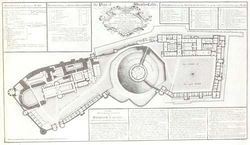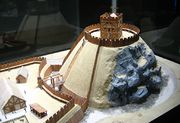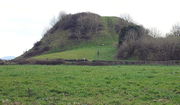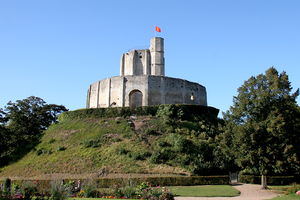Motte-and-bailey


A motte-and-bailey is a form of castle situated on a raised earthwork and surrounded by a protective fence. Many were built in Britain, Ireland and France in the 11th and 12th centuries, favoured as a relatively cheap but effective defensive fortification that could repel most small attacks.

A motte is a mound, often artificial, topped with a wooden or stone structure known as a keep. The earth for the mound would be taken from a ditch, dug around the motte or around the whole castle. The outer surface of the mound could be covered with clay or strengthened with wooden supports. There are two surviving examples of castles with two mottes, one being Lewes Castle and the other Lincoln Castle. Most were originally topped with wooden structures, which could be built with readily available materials and without highly skilled labour, although many such structures were later replaced with stone keeps.

A bailey is an enclosed courtyard, typically surrounded by a wooden fence called a palisade which would be overlooked by the motte. It was usually used as a living area by servants who served the lord of the castle or farmers, Inside the bailey was also a blacksmith, a miller and most of the necessary craftsmen of this age. A castle could have more than one bailey, sometimes an inner and an outer, such as at Warkworth Castle, where expansion of the castle led to enclosure of a new bailey with a wall. Alternatively, the multiple baileys could flank the motte, such as at Windsor Castle. The bailey was often directly connected to the ditch surrounding the motte. The bailey was often enclosed inside another wooden palisade and surrounding ditch, so as to add an extra layer of protection. It was connected to the motte by a timber drawbridge, which could be separated from the bailey as a last defence mechanism. There was in many cases another drawbridge at the entrance into the bailey that could similarly be raised for protection. The bailey would typically contain a hall, stables for the horses and cattle, a chapel, and huts for the nobleman's people. There were often shops inside the bailey for local merchants.
Motte and bailey castles later evolved into Norman castles that evolved later into even better Concentric castles.
Examples
- Alnwick Castle
- Arundel Castle
- Bedford Castle
- Berkeley Castle
- Brinklow Castle
- Cardiff Castle
- Carisbrooke Castle
- Castle Neroche
- Château de Gisors
- Durham Castle
- Fotheringhay Castle
- Lewes Castle
- Launceston Castle
- Moate
- Mold Castle
- Montacute
- Motte of Urr
- Nether Stowey
- Nottingham Castle
- Okehampton Castle
- Ongar Castle
- Oxford Castle
- Reigate Castle
- Stafford Castle
- Tamworth Castle
- Totnes Castle
- Warwick Castle
- Warkworth Castle
- Windsor Castle
- Wiston Castle
External links
- Some Motte & Bailey sites in Northumberland, England
- Castles of Britain
- Account of William the Conqueror's building
- Timeref
- Motte-and-bailey castles of Wales
- The Twmpath motte, Cardiff, Wales
- List of motte-and-bailey castles in Britain
- An introduction to motte-and-bailey castles
- Motte-and-bailey entry in MedArt Glossary of Medieval Art and Architecture
|
|||||||||||||||||